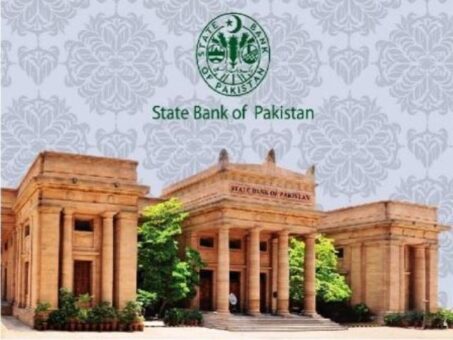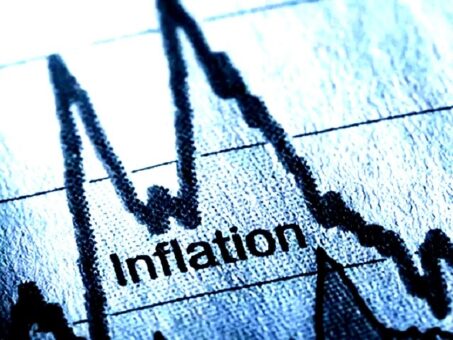On Wednesday, August 03, 2022, the State Bank of Pakistan (SBP) released the foreign exchange rates for customers, shedding light on the buying and selling prices of various currencies against the Pakistani Rupee (PKR).
(more…)Tag: SBP
-

Foreign investors discuss economic situation with SBP
KARACHI: Foreign investors operating in the country have discussed ongoing economic situation with the State Bank of Pakistan, a statement said on Tuesday.
The members of Overseas Investment Chamber of Commerce and Industry (OICCI), the body representing foreign investors and multinational companies in Pakistan, met with Dr. Murtaza Syed, Acting Governor, State Bank of Pakistan (SBP), Dr. Inayat Hussain, Deputy Governor, SBP and Sima Kamil, Deputy Governor, SBP for a discussion on urgent fiscal and monetary policy measures that need to be taken to help stabilize Pakistan’s economy.
READ MORE: SBP introduces foreign currency, rupee value business accounts
Ghias Khan, President OICCI and Abdul Aleem, Secretary General, OICCI led the discussions and raised member concerns related to the pre-approval procedure of LCs for import of machinery and spare parts, timely remittance payments, approval exemptions of shipping values being too low, and other operational issues. It was stressed upon the SBP leadership to set timelines so that industry supply chain is not compromised.
The SBP team gave a comprehensive overview of the current economic situation and the planned strategy to tackle issues in 2023. Pakistan is primarily a consumer-driven economy with consumption driving up to 95 per cent of the GDP. The SBP team was confident that Pakistan’s problems were temporary and urged the OICCI members to work on improving exports to help balance the exchange rate fluctuations and currency depreciation.
READ MORE: Rupee makes recovery against dollar for 3rd straight day
Ghias Khan stated: “This meeting was a much needed first step towards the recovery of Pakistan’s economy. It is imperative that we implement cogent measures to halt our pattern of circular debt. The SBP has always played a critical role in stabilizing Pakistan’s economy, and I am confident that under Dr. Murtaza Syed’s leadership we will be able to withstand the current economic climate while charting a path for growth.”
READ MORE: OICCI suggests duty cut on locally manufactured cars
Dr. Murtaza Syed commented, “SBP is taking tough measures and making difficult decisions to help avert the economic crisis. Global inflationary pressures coupled with a procyclical expansionary fiscal policy during a pro-cyclical period is one of the main reasons Pakistan is at this crossroads today. Once these measures are implemented and the IMF loan is received, the pressures on the economy will ease, specifically with regards to the depreciating Rupee.”
OICCI serves as a platform to promote foreign investments and plays a major role in the growth of commerce and industry in the country. Collectively, OICCI invested USD 2.4 billion last year, contributing one-third of the country’s total tax collections.
READ MORE: Return filing be made mandatory for account holders
-

SBP issues KIBOR rates – August 02, 2022
KARACHI: State Bank of Pakistan (SBP) on Tuesday issued the Karachi Interbank Offered Rates (KIBOR) as on August 02, 2022.
Following are the latest KIBOR rates:
Tenor BID OFFER 1 – Week 14.74 15.24 2 – Week 14.80 15.30 1 – Month 14.89 15.39 3 – Month 15.53 15.78 6 – Month 15.63 15.88 9 – Month 15.67 16.17 1 – Year 15.71 16.21 -

SBP imposes Rs85 million as penalty on JS Bank
KARACHI: The State Bank of Pakistan (SBP) has imposed a monetary penalty of Rs85 million on JS Bank Limited for violating regulatory instructions.
The central bank said that JS Bank Limited had violated regulatory instructions pertaining to Customer Due Diligence (CDD) / Know Your Customer (KYC), Asset Quality, foreign exchange and general banking operations.
READ MORE: SBP introduces foreign currency, rupee value business accounts
The SBP directed the bank to strengthen its controls/processes in the identified areas.
The central bank on Tuesday issued details of enforcement actions against banks during the quarter ended June 30, 2022.
The SBP imposed a total amount of Rs131.42 million on three banks during the quarter.
An amount of Rs29.03 million as penalty has been imposed on Habib Bank Limited for violating regulatory instructions pertaining to CDD/KYC. The SBP also directed Habib Bank to strengthen its controls / processes in the identified areas.
READ MORE: Pakistani rupee overshoots temporarily: FinMin, SBP
Furthermore, the SBP imposed an amount of Rs17.24 million as penalty on the Bank of Punjab for violating regulatory instructions pertaining to Asset Quality and CDD/KYC. In addition to penal action, the bank has been advised to strengthen its controls / processes in the identified areas.
The SBP from July 2019 started public disclosure of penal action against banks. “Enforcement actions are an integral part of the regulatory regime which involves imposition of monetary penalties and other actions against institutions and individuals for violations of laws, rules, regulations, guidelines or directives issued by SBP from time to time,” according to a circular issued by the central bank.
In order to bring more transparency and strengthen market discipline, SBP has decided to publicly disclose significant enforcement actions.
READ MORE: Rupee fall to continue till IMF fund realization: Pakistan’s top bank
-

SBP’s customer forex rates – August 02, 2022
On Tuesday, August 02, 2022, the State Bank of Pakistan (SBP) published the foreign exchange rates for customers, offering insights into the buying and selling prices of various currencies against the Pakistani Rupee (PKR).
(more…) -

High inflation may force further monetary tightening
The relentless surge in inflationary pressures may prompt the State Bank of Pakistan (SBP) to consider additional measures to tighten the monetary stance, as the central bank has already elevated the policy rate to 15 percent.
(more…) -

SBP introduces foreign currency, rupee value business accounts
KARACHI: The State Bank of Pakistan (SBP) has announced a new category of foreign currency and rupee value business accounts to enhance financial inclusion and facilitate non-resident Pakistani investors.
(more…) -

SBP issues KIBOR rates – August 01, 2022
KARACHI: State Bank of Pakistan (SBP) on Monday issued the Karachi Interbank Offered Rates (KIBOR) as on August 01, 2022.
Following are the latest KIBOR rates:
Tenor BID OFFER 1 – Week 14.86 15.36 2 – Week 14.90 15.40 1 – Month 14.97 15.47 3 – Month 15.52 15.77 6 – Month 15.63 15.88 9 – Month 15.65 16.15 1 – Year 15.73 16.23 -

SBP’s customer forex rates – August 01, 2022
On Monday, August 01, 2022, the State Bank of Pakistan (SBP) released the foreign exchange rates for customers, providing essential information on the buying and selling prices of various currencies against the Pakistani Rupee (PKR).
(more…) -

Pakistani rupee overshoots temporarily: FinMin, SBP
KARACHI: The Pakistani rupee has overshot temporarily but it is expected to appreciate in next few months, said a joint statement issued on Sunday late night by the Finance Ministry (FinMin) and the State Bank of Pakistan (SBP).
According to the statement the rupee has overshot temporarily but it is expected to appreciate in line with fundamentals over the next few months.
The statement strongly rejected rumors that a particular level of the exchange rate has been agreed with the IMF are completely unfounded. “The exchange rate is flexible and market-determined, and will remain so, but any disorderly movements are being countered,” it added.
READ MORE: Pakistani rupee falls 36% to Saudi Riyal in seven months
The statement pointed out around half of the rupee depreciation since December 2021 can be attributed to the global surge in the US dollar, following historic tightening by the Federal Reserve and heightened risk aversion.
“Of the remaining half, some is driven by domestic fundamentals. In particular, the widening of the current account deficit, especially in the last few months,” it added.
As noted above, the deficit is expected to narrow going forward as the temporary surge in the import bill is brought under control. As this happens, the Rupee is expected to gradually strengthen.
The remaining depreciation has been overdone and driven by sentiment. The Rupee has overshot due to concerns about domestic politics and the IMF program.
This uncertainty is being resolved, such that the sentiment-driven part of the Rupee depreciation will also unwind over the coming period.
Where the market has become disorderly, the State Bank has continued to step in through sales of US dollars to calm the markets and will continue to do so, as needed in the future.
READ MORE: Rupee fall to continue till IMF fund realization: Pakistan’s top bank
Strong steps to counter any speculation have also been taken, including close monitoring and inspections of banks and exchange companies. Further additional measures will be taken as situation warrants.
Going forward, as the current account deficit is curtailed and sentiment improves, we fully expect the Rupee to appreciate. Indeed, this was the experience during the beginning of the IMF program in 2019, when the Rupee strengthened considerably after a period of weakness in the lead-up to the program.
Clearly, the Rupee can overshoot temporarily as it has done recently. However, it moves both ways over time. We expect this pattern to re-assert itself in the coming period. As a result, the Rupee should strengthen in line with improved fundamentals in the form of a smaller current account deficit as well as stronger sentiment.
Pakistan’s problems are temporary and are being forcefully addressed. “Pakistan’s foreign exchange reserves have fallen since February as foreign exchange inflows have been outpaced by outflows.”
The inflows mainly comprise of multilateral loans from the IMF, World Bank and ADB; bilateral assistance in the form of deposits and loans from friendly countries like China, Saudi Arabia, and the UAE; and commercial borrowing from foreign banks and through the issuance of Eurobonds and Sukuks.
The paucity of inflows has happened in large part due to the delay in completing the next review of the IMF program, which has lingered since February due to policy slippages.
READ MORE: Pakistani rupee crashes 17% against dollar in July 2022
Meanwhile, on the outflows side, debt servicing on foreign borrowing has continued as repayments on these debts have been coming due over this period.
At the same time, the exchange rate has come under significant pressure, especially since mid-June. It has been driven by general US dollar tightening, a rise in the current account deficit (exacerbated by a heavy energy import bill in June), the decline in foreign exchange reserves, and worsening sentiment due to uncertainty about the IMF program and domestic politics.
However, important developments have happened recently that will address both of these temporary issues. On July 13, the critical milestone of a staff-level agreement on completing the next IMF review was reached. As of today, all prior actions for completing the review have been met and the formal Board meeting to disburse the next tranche of $1.2 billion is expected in a couple of weeks.
At the same time, macroeconomic policies—both fiscal policy and monetary policy—have been appropriately tightened to reduce demand-led pressures and rein in the current account deficit. Finally, the government has clearly announced that it intends to serve out the rest of its term until October 2023 and is ready to implement all the conditions agreed with the Fund over the remaining 12 months of the IMF program.
In FY23, Pakistan’s gross financing needs will be more than fully met under the on-going IMF program.
The financing needs stem from a current account deficit of around $10 billion and principal repayments on external debt of around $24 billion.
READ MORE: Pakistan interbank rupee ends Rs239.37 to dollar on July 29, 2022
In order to bolster Pakistan’s foreign exchange reserves position, it is important for Pakistan to be slightly over-financed relative to these needs.
As a result, an extra cushion of $4 billion is planned over the next 12 months. This funding commitment is being arranged through a number of different channels, including from friendly countries that helped Pakistan in a similar way at the beginning of the IMF program in June 2019.
Important measures have been taken to contain the current account deficit.
In addition to high global commodity prices, the large current account deficit in FY22 was driven by rapid domestic demand (growth reached almost 6 percent for two consecutive years leading to overheating of the economy), artificially low domestic energy prices due to the February subsidy package, an unbudgeted and procyclical fiscal expansion, and heavy energy imports in June to minimize load-shedding and build inventories.
To contain this deficit going forward, the policy rate was raised by 800 basis points, the energy subsidy package has been reversed, and the FY23 budget targets a consolidation of nearly 2.5 percent of GDP, centered on tax increases while protecting the most vulnerable. This will help cool domestic demand, including for fuel and electricity.
In addition, temporary administrative measures have been taken to contain the import bill, including requiring prior approval before importing automobiles, mobile phones and machinery. These measures will be eased as the current account deficit shrinks in the coming months.
These measures are working: the import bill fell significantly in July, as energy imports have declined and non-energy imports continue to moderate.
Foreign exchange payments in July were significantly lower than in June. This is true for both oil and non-oil payments. Altogether, payments were a sustainable $6.1 billion in July compared to $7.9 billion in June.
The latest trade data indicate that non-oil imports continue to fall. Specifically, non-oil imports fell by 5.7 percent quarter-on-quarter during Q4 FY22. They are expected to reduce further going forward.
Looking ahead, a considerable slowdown has been witnessed in LC opening in recent weeks, again for both oil as well as non-oil commodities. Based on market reports, there was an 11% month-on-month decline in Oil Marketing Companies sales volume in June.
After the surge in energy imports in June, a stock of diesel and furnace oil sufficient for 5 and 8 weeks, respectively, is now available in the country, much higher than the normal range of 2 to 4 weeks in the past. This implies a lower need for petroleum imports going forward.
With the recent rains and storage of water in the dams, hydroelectricity is also likely to increase and need to generate electricity on imported fuel is expected to decline going forward.
As a result of these trends, the import bill is likely to shrink going forward and should begin to manifest itself more forcefully in lower FX payments over the next 1-2 months.
Overall, imports are expected to decline in coming months due to a decline in global commodity prices, the higher oil stock, the unfolding impact of higher domestic prices of petroleum products, adjustments in electricity and gas tariffs, the removal of tax exemptions under the FY23 budget, administrative measures taken to curtail imports, and the lagged impact of the monetary and fiscal tightening that has been undertaken.